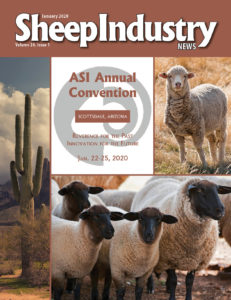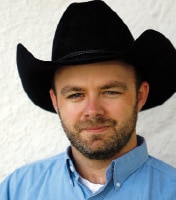JULIE STEPANEK SHIFLETT, PH.D.
Juniper Economic Consulting
American lamb producers continue to face many headwinds, including the currently depressed wool and pelt markets due to the ongoing U.S.-China trade war. An equally pressing concern is a market failure and a lack of communication between consumer demands at retail back down the marketing channel to lamb producers. All market participants, from producers, to feeders to packers can simultaneously grow and profit if working together.
The price spread between the wholesale lamb market and the live lamb market appears to be widening. In the five years to 2019, the wholesale cutout gained 8 percent to $390 per cwt., the formula slaughter lamb price fell 4 percent to $287 per cwt., and the difference between the two shot up to $103 per cwt., doubling from $54 per cwt. that defined the margin in 2005-2014. The wholesale cutout is not a carcass price, but a price calculated by putting the price of individual wholesale primals such as the leg and shoulder back together.
In theory, this margin can be explained by processing margins, value added and profit. As the meat market adds value in more consumer-friendly offerings, this margin will widen. It is not known empirically, however, whether added value does indeed explain the widening margin. It therefore opens the door to the possibility that large packers are using their market power to depress live lamb prices.
In recent years, the meat market has been hot. The wholesale rack hit a record $9.23 per lb. in 2017 and flirted with $9 in 2019. The wholesale shoulder averaged 93 percent of its all-time high in 2019. Meanwhile, the live lamb market remained sluggish to lower.
Americans love domestic lamb, but the stagnation in live lamb prices suggests that this message is not communicated down to producers. As agricultural markets become more concentrated, price signals between marketing channels (from producer to retail) become an increasingly poor way to communicate consumer demands to producers. There is a breakdown, a disconnect. That is, unless prices – such as the wholesale cutout – accurately reflect consumer demand.
Seasonal Analysis Forecasting Tool
A seasonal analysis can help producers determine how significant last year’s prices are as a predictor of this year’s price.
For some months, historical data is helpful, but for other months, not as reliable. A graph showing a seasonal average of slaughter lamb prices on formula (or grid) also shows the confidence interval of this average, plus and minus one standard deviation. The standard deviation measures the variability of the monthly historical data. It is useful in showing how reliable the average is as an indicator of the expected price in a particular month and year (Texas A&M). In the slaughter lamb market in the past five years, prices were most consistent around Easter year-to-year. The standard deviation is largest during January, which means the average price is not a very good predictor of prices during early 2020. The standard deviation is also large during the summer months.
LMIC Forecasts
The Livestock Marketing Information Center forecasted in early December that commercial production could be down 2 percent in 2019 over 2018 and imports could be down 4 percent. However, lamb consumption was not down: A significant freezer inventory that held over from 2018 into 2019 helped support lamb availability in 2019.
LMIC painted a very different picture for 2020 with beginning stocks dropping by half compared to early 2019. Production is expected to be down 1 percent year-on-year in 2020 and imports up a modest 1 percent.
Total availability will likely stay about steady to marginally higher because a freezer inventory will be drawn down.
It is difficult to say as of this writing, but freezer inventories heading into 2020 might be higher than expected, depending upon December holiday sales. If inventories are higher, and imports slow, then it is possible that tighter supplies could help support the live lamb market. The meat market is expected to stay strong, for underlying lamb demand is solid.
Lamb imports will likely remain strained in 2020. The Australian Department of Agriculture reported in September that lamb and mutton production is expected to fall in 2019-20. Lamb slaughter is forecast to fall due to fewer lambs being available for slaughter and flock rebuilding, weather permitting.
Lamb imports totaled 182.6 million lbs. in January through October 2019, up 7 percent year-on-year. Australian lamb imports totaled 134.0 million lbs., up 7 percent and New Zealand imports were up 8 percent to 46.9 million lbs.
Although lamb production will be down, its lamb exports are not expected to fall proportionally as Australian domestic consumers switch to relatively more competitive proteins as lamb prices rise.
It is forecasted that lamb imports could rise year-on-year in 2020 by more than the LMIC-forecasted 1 percent. The United States market likely has a higher price ceiling defined by consumers’ demand compared to other export markets. ABARES commented, “Uncertainty surrounds China’s willingness to pay for increasingly expensive mutton or to substitute toward higher-priced Australian lamb,” (ABARES, 9/2019).
LMIC forecasted in early December that national, direct slaughter lamb prices on a carcass basis could average $277 to $282 per cwt. in the first quarter, up 6 percent year-on-year. LMIC also forecasted that feeder lamb prices (60 to 90 lbs.) could average $188 to $197 per cwt. in the first quarter, up 2 percent year-on-year.
Meat Market Higher
The lamb wholesale cutout averaged $401.26 per cwt. in November, 1 percent higher monthly and 6 percent higher year-on-year. All primals moved higher in November, except for the leg. The loin, trimmed 4×4, averaged $525 per cwt., 2 percent higher in November. The 8-rib rack, medium, averaged $883 per cwt., 1 percent higher monthly. The shoulder, square-cut, averaged $330.87 per cwt., 1 percent higher monthly.
The leg, trotter-off, averaged $381.76 per cwt., down 1 percent monthly.
The shoulder saw an unprecedented 17 percent gain year-on-year in November. The leg was higher year-on-year, up 6 percent annually. The rack was 2 percent higher year-on-year. The loin gained monthly, but lost 4 percent year-on-year.
Ground lamb averaged $559.64 per cwt., down 2 percent monthly and down 3 percent year-on-year.
Lamb Production Lower in 2019
Estimated lamb harvest was 1.7 million head in January through November, 1 percent higher year-on-year. Estimated lamb production was 84.3 million lbs., down 4 percent year-on-year. Production was down because dressed weights fell 5 percent in this period to 67 lbs.
In October, 20 percent of lamb harvested was yield grades 4 and 5, indicative of heavier back fat. For the year through October, 28 percent of the lamb harvested was yield grade 4 and 5.
By early December the lamb industry was current in getting its lambs to market, as seen in falling dressed weights. As dressed weights fall, so too will lambs grading 4 and 5. In early December, 192,313 head of feeder lambs were reported in Colorado feedlots which was 82 percent of 2018’s December inventory and 83 percent of the five-year average for December.
At the beginning of December, the amount of lamb and mutton in cold storage was 36.4 million lbs., down 13 percent monthly and down 7 percent year-on-year. December’s inventory was 77 percent of its record high recorded in early 2016.
Feeder Market Mixed
In general, the commercial feeder lamb market has seen a downward trend during the past five years. However, 2019 averages were higher relative to 2018. As supplies tighten in 2019, the commercial feeder lamb market could see a lift.
Commercial feeder lamb prices at auction in Sioux Falls, S.D., for 60 to 90 lb. feeders averaged $183.70 per cwt., 2 percent higher monthly and 13 percent higher year-on-year. Prices in the Billings, Mont., commercial feeder market averaged $200.58 per cwt., down 5 percent monthly and about steady with a year ago. A concern in 2020 is that as more feeder lambs are privately contracted, available information on feeder lamb auction prices might become thin.
Slaughter Lamb Market Higher Year-on-Year
Live, negotiated slaughter lamb prices averaged $151.94 per cwt. in November, 2 percent higher monthly and 13 percent higher year-on-year. Average weights were 137 lbs., 8 percent higher monthly and 10 percent lower from a year ago.
Slaughter lambs on formula averaged $295.33 per cwt. on a carcass basis, down one-half percent and up 9 percent year-on-year. Carcass weights averaged 73 lbs., down 2 pounds from a year ago. The live equivalent price was $148.08 per cwt. in November.
Lamb prices in the nontraditional lamb market – as reported in the New Holland (Penn.) livestock auction – were 5 to 18 percent higher in November year-on-year, depending upon weight and quality. Hair sheep weighing 80 to 90 lbs. live weight grading choice 2 and 3 averaged $162.70 per cwt. in November, 6 percent higher monthly and 18 percent higher year-on-year.
Predictably Unpredictable Raw Wool Market
Australian Wool Innovation Ltd. called the 2019 wool markets “predictably unpredictable,” (AWI, 12/2019). This uncertainty will likely continue into 2020.
The AWEX Eastern Market Indicator averaged Australian 1,562 cents (Ac) per kg clean in November, up 2 percent monthly yet down 14 percent year-on-year. By early December, the EMI had dipped below 1,400 Ac, down for the third consecutive week and down 19 percent year-on-year.
The ongoing United States-China trade war will be the single most important influence on wool and pelt markets in 2020. To date, the trade war has cost United States taxpayers $23 billion of earmarked trade adjustment payments. This is money that could help expand export markets to American agriculture, thus boosting farm incomes. Lamb and wool growers are immediately hurt by the trade war, for they are losing large and growing export markets. It is unknown how long it will take to recover this lost opportunity.
ABARES reported, “The global economic slowdown resulting from the China–United States trade dispute has dampened demand for textiles and forced prices of natural and synthetic fibers down. Wool and cotton prices are forecast to fall in 2019-20,” (12/2019).
American raw wool exports dropped 34 percent year on-year to 2.2 million kgs. In the October to September 2018-19 marketing year total exports were 3.4 million kgs clean, a 26 percent drop. Raw wool exports to China fell 65 percent to 896,339 kgs. Egypt was our No. 2 export market behind China. Exports to Egypt increased more than 500 percent to 686,257 kgs. In the top five largest export markets, exports to Bulgaria dropped 20 percent to 154,033 kgs.
Yarn exports were off 10 percent to 477,550 kgs while wool fabric exports were down 9 percent to 1.4 million square meters in 2018-19.
In the 2018-19 marketing year, pelt exports dropped 26 percent to 664,691 pieces. Leather exports fell 32 percent to 34,159 square meters.





